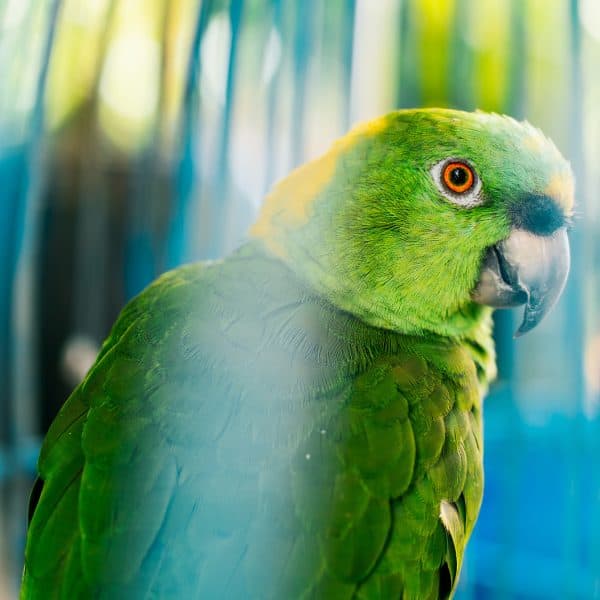Last Updated on by Mitch Rezman
Attn. Mitch Rezman
Fluorescent lights.
The recent post here on Vit. D led me to more research. It appears most if not all of the Windy City Full Spectrum lights have simple magnetic ballasts, producing visible flicker. This is proven for chickens and assumed for the likely better eyes of psittacines with their mainly flying lifestyle.
High-frequency electronic ballasts are now standard for indoor fluorescents where human health is a consideration as the high-frequency flicker is far faster than our visual system can perceive. https://en.wikipedia.org/wiki/Electrical_ballast>Electronic Ballasts) Commonly about 3500 Hz in Compact Fluorescent Lights. HF ballasts are now competitive with previous mains rate (120Hz) magnetic ballasts products and are offered in full spectrum phosphors lights.
Dr. Mercola (Mercola Health Resources, LLC, no connection, yadda yada) now offers these in ratings at least as good as any Windy City presently does in a 30w bulb.
I’m guessing if the current stock at Windy City had high-frequency electronic ballasts, this would be advertised. If not, it Should. As perceptible flicker is considered an environmental stressor in humans and other higher life forms, some investigation may reveal the source that Dr. Mercola is using and birds will benefit from the particularly targeted messages and products Windy City distributes.
Other notes: It needs mentioning that only specially designed compact fluorescent bulbs are compatible with most home light dimmers, none of which are conventional magnetic ballasts, and not all electronic ballasts. Dr. Mercola’s don’t seem to be. Of the suitable electronic ballasts, it’s still recommended they be used at full capacity for >100 hours before any dimming, or they darken and lose service life.
Ophthalmologists, other MDs, and archival museum people will also caution that full spectrum lighting has serious downsides! We do not have eyes that will survive full-time UV outdoor exposure without increased risk of cataracts. Eventually All get them, the question is at how young of an age. (Mine were at 58) Birds I observe also do Not spend time in the Sun when not necessary. The shade of some sort is common to all roosts other than predators watching for opportunities to feed.
Household windows filter 100% of all ultraviolet light which helps prevent the fading of your home’s furnishings.
For other downsides of fluorescent lighting (Mostly associated with UV, no specific mention of Flicker.) see: https://en.wikipedia.org/wiki/Fluorescent_lamps_and_health
Museums and art galleries specifically forbid Full Spectrum lighting as it’s well understood how many materials including most art pigments are degraded far more by UV light than by the normal human visual spectrum.
This has real implications. I’m just starting with indoor full spectrum lights and plan to shade the computer display with its sensitive phosphors from direct light from the UV bulbs.
I’m also working on shading my Cockatoo’s usual perches but leaving others in direct view. It needs constant repeating that a bird with a full spectrum light too close by risks damage to their eyes and skin, just as we do. Our parrots have enough problems without being blind from cataracts. I’ve seen a couple.
I greatly prefer someone doing adequate tests with modern full spectrum sensor equipment of All available lights and publishing measured UVA and UVB intensities at useful ranges of distances, particularly Too Close. Few are going to calculate intensity from any one figure even if they do understand the area square rule.
In service of all the parrots we love
Bill
Hi Bill
It is good to see that you understand the inverse square law of light (and sound and energy) but have you ever run the numbers? A 1000 lm lamp on top of a 4-foot tall (interior height) birdcage to displays only 84 lm on the floor the cage.
Thus shading your computer displays from the direct UV rays you think the bulbs are emiting is literally like protecting the screens from the light of a lit candle
Let’s start with part of Wikipedia’s definition of full-spectrum
“Full-spectrum” is not a technical term when applied to an electric light bulb but rather a marketing term implying that the product emulates natural light.
Products marketed as “full-spectrum” may produce light throughout the entire spectrum, but actually do not produce an even spectral distribution, and may not even differ substantially from lights not marketed as “full-spectrum”.
Thus as stated on Mercola’s site:
‘Products marketed as “full-spectrum” may produce light throughout the entire spectrum, but actually do not produce an even spectral distribution, and may not even differ substantially from lights not marketed as “full-spectrum”’
Is a falsehood. As long as a full spectrum bulb is rated at 5500 K it’s full-spectrum regardless of UVA or UVB
Again from Wikipedia
The CRI of a light source does not indicate the apparent color of the light source; that information is under the rubric of the correlated color temperature (CCT). In the pictures on right it can be noticed that the spectra have different structures; the incandescent lamp has a continuous spectrum, whereas the fluorescent lamp has separate lines in the spectrum due to emission of photons of discrete wavelengths by mercury.
The value often quoted as ‘CRI’ on commercially available lighting products is properly called the CIE Ra value, ‘CRI’ being a general term and CIE Ra being the international standard color rendering index.
Numerically, the highest possible CIE Ra value is 100, and would only be given to a source identical to standardized daylight or a black body (incandescent lamps are effectively black bodies), dropping to negative values for some light sources.
Low-pressure sodium lighting has negative CRI; fluorescent lights range from about 50 for the basic types, up to about 90 for the best tri-phosphor type. Typical LEDs have about 80+ CRI, while some manufacturers claim that their LEDs have achieved up to 98 CRI.
Further full spectrum LED lighting is becoming a mainstream Item we hope to be stocking soon.
Caveat: Birds and full spectrum lighting. We got it wrong.
Best of luck,
Written and approved by the Windy City Parrot Content Team
Author Profile
Latest entries
 The Traveling BirdJune 26, 2025Can You Name 5 Parrot Species That Are Living Wild in the USA?
The Traveling BirdJune 26, 2025Can You Name 5 Parrot Species That Are Living Wild in the USA? Bird BehaviorJune 26, 2025How is it Parrots Are Problem Solvers Social Animals and Even Use Tools?
Bird BehaviorJune 26, 2025How is it Parrots Are Problem Solvers Social Animals and Even Use Tools? Bird & Parrot AnatomyJune 25, 2025How a Tiny Chemical Modification Makes Parrots Nature’s Living Paintings
Bird & Parrot AnatomyJune 25, 2025How a Tiny Chemical Modification Makes Parrots Nature’s Living Paintings PigeonsJune 20, 2025How Do Parrots Thrive in Cities Outside Their Native Habitats?
PigeonsJune 20, 2025How Do Parrots Thrive in Cities Outside Their Native Habitats?




